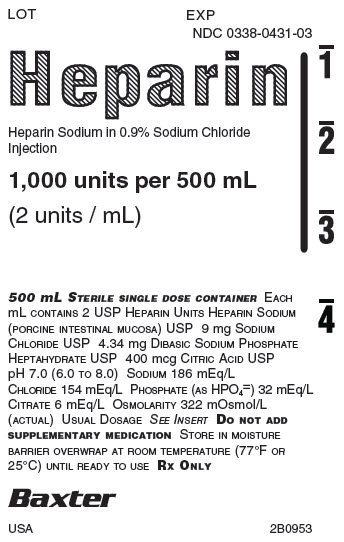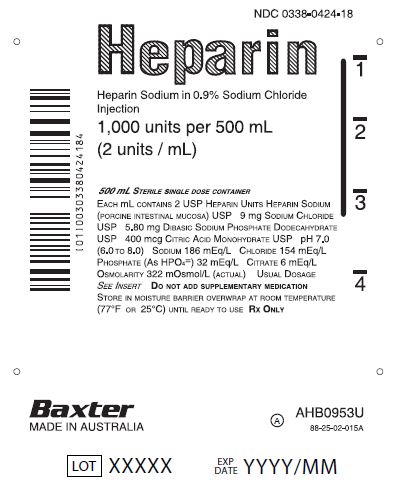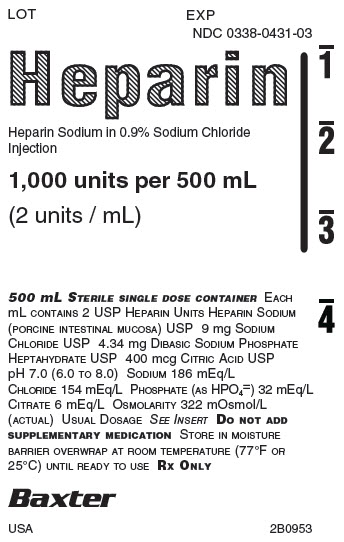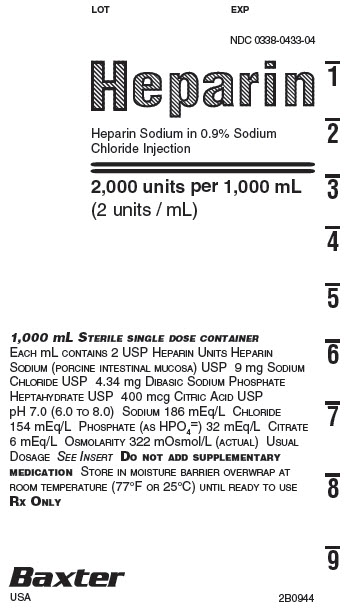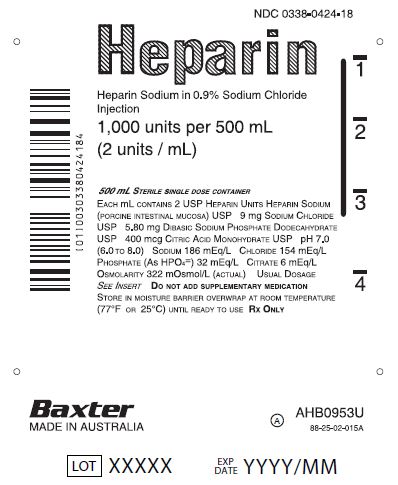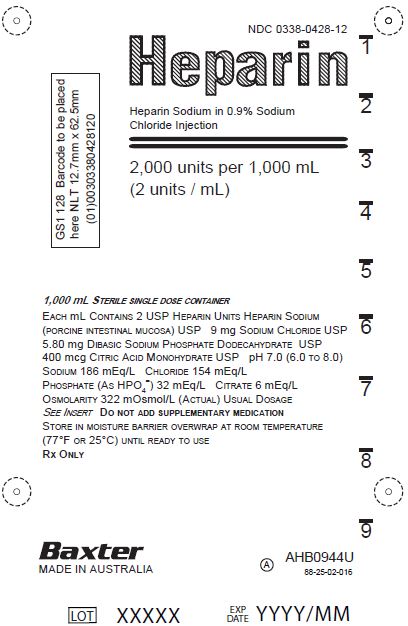Label: HEPARIN SODIUM IN SODIUM CHLORIDE- heparin sodium injection, solution
- NDC Code(s): 0338-0424-18, 0338-0428-12, 0338-0431-03, 0338-0433-04
- Packager: Baxter Healthcare Corporation
- Category: HUMAN PRESCRIPTION DRUG LABEL
- DEA Schedule: None
- Marketing Status: New Drug Application
Drug Label Information
Updated January 3, 2022
If you are a consumer or patient please visit this version.
- Download DRUG LABEL INFO: PDF XML
- Official Label (Printer Friendly)
-
HIGHLIGHTS OF PRESCRIBING INFORMATION
These highlights do not include all the information needed to use HEPARIN SODIUM IN SODIUM CHLORIDE INJECTION safely and effectively. See full prescribing information for HEPARIN SODIUM IN SODIUM CHLORIDE INJECTION.
HEPARIN SODIUM IN SODIUM CHLORIDE injection, for intravenous use
Initial U.S. Approval: 1939RECENT MAJOR CHANGES
INDICATIONS AND USAGE
Heparin Sodium in Sodium Chloride Injection at a concentration of 2 units/mL is indicated as an anticoagulant to maintain catheter patency. (1)
DOSAGE AND ADMINISTRATION
Infuse through intravenous catheter at a rate of 6 units per hour. (2.2)
DOSAGE FORMS AND STRENGTHS
CONTRAINDICATIONS
Heparin Sodium in Sodium Chloride Injection is contraindicated in patients with the following conditions: (4)
- •
- With an uncontrollable active bleeding state, except when this is due to disseminated intravascular coagulation (5.1)
- •
- With a history of heparin-induced thrombocytopenia (HIT) or heparin-induced thrombocytopenia with thrombosis (HITT) (5.2)
- •
- With severe thrombocytopenia (5.2, 5.3)
- •
- Known hypersensitivity to heparin or pork products (5.5)
WARNINGS AND PRECAUTIONS
- •
- Hemorrhage: Fatal cases have occurred. Monitor for signs of bleeding and manage promptly. (5.1)
- •
- HIT and HITT: Monitor for signs and symptoms and discontinue if indicative of HIT or HITT. (5.2)
- •
- Hyperkalemia: Measure plasma potassium in patients at risk of hyperkalemia before starting heparin therapy and periodically in all patients. (5.6)
- •
- Elevations of serum aminotransferases: Interpret elevation of these enzymes with caution. (5.7)
ADVERSE REACTIONS
Most common adverse reactions are: hemorrhage, thrombocytopenia, HIT and HITT, hypersensitivity, and elevations of aminotransferase levels. (6.1)
To report SUSPECTED ADVERSE REACTIONS, contact Baxter Healthcare at 1-866-888-2472 or FDA at 1-800-FDA-1088 or www.fda.gov/medwatch.
DRUG INTERACTIONS
Drugs that interfere with platelet aggregation or drugs that counteract coagulation may induce bleeding (7.2)
USE IN SPECIFIC POPULATIONS
See 17 for PATIENT COUNSELING INFORMATION.
Revised: 1/2022
-
Table of Contents
FULL PRESCRIBING INFORMATION: CONTENTS*
1 INDICATIONS AND USAGE
2 DOSAGE AND ADMINISTRATION
2.1 Preparation for Administration
2.2 Maintenance of Catheter Patency
3 DOSAGE FORMS AND STRENGTHS
4 CONTRAINDICATIONS
5 WARNINGS AND PRECAUTIONS
5.1 Hemorrhage
5.2 Heparin-Induced Thrombocytopenia and Heparin-Induced Thrombocytopenia with Thrombosis
5.3 Thrombocytopenia
5.4 Heparin Resistance
5.5 Hypersensitivity
5.6 Hyperkalemia
5.7 Elevations of Serum Aminotransferases
5.8 Laboratory Tests
6 ADVERSE REACTIONS
6.1 Postmarketing Experience
7 DRUG INTERACTIONS
7.1 Oral Anticoagulants
7.2 Platelet Inhibitors
7.3 Other Medications that May Interfere with Heparin
8 USE IN SPECIFIC POPULATIONS
8.1 Pregnancy
8.2 Lactation
8.4 Pediatric Use
8.5 Geriatric Use
10 OVERDOSAGE
11 DESCRIPTION
12 CLINICAL PHARMACOLOGY
12.1 Mechanism of Action
12.2 Pharmacodynamics
12.3 Pharmacokinetics
13 NONCLINICAL TOXICOLOGY
13.1 Carcinogenesis, Mutagenesis, Impairment of Fertility
16 HOW SUPPLIED/STORAGE AND HANDLING
17 PATIENT COUNSELING INFORMATION
- *
- Sections or subsections omitted from the full prescribing information are not listed.
- 1 INDICATIONS AND USAGE
-
2 DOSAGE AND ADMINISTRATION
2.1 Preparation for Administration
Do not administer unless solution is clear, and seal is intact. Parenteral drug products should be inspected visually for particulate matter and discoloration prior to administration whenever solution and container permit. Do not infuse this product under pressure.
To Open:
Tear overwrap down side at slit and remove solution container. Visually inspect the container. If the outlet port protector is damaged, detached, or not present, discard container as solution path sterility may be impaired. Some opacity of the plastic due to moisture absorption during the sterilization process may be observed. This is normal and does not affect the solution quality or safety. The opacity will diminish gradually. Check for minute leaks by squeezing inner bag firmly. If leaks are found discard solution as sterility may be impaired. Do not add supplementary medication.
Preparation for Administration:
- 1.
- Suspend container from eyelet support.
- 2.
- Remove plastic protector from outlet port at bottom of container.
- 3.
- Attach administration set. Refer to complete directions accompanying set.
All injections in VIAFLEX PLUS plastic containers are intended for administration using sterile equipment.
Single-dose container.
Discard any unused portion.
Do not reconnect partially used bags.
Because dosages of this drug are titrated to response, no additives should be made to Heparin Sodium in Sodium Chloride Injection.
Heparin sodium is not effective by oral administration and Heparin Sodium in Sodium Chloride Injection should not be given orally.
- 3 DOSAGE FORMS AND STRENGTHS
-
4 CONTRAINDICATIONS
The use of Heparin Sodium in Sodium Chloride Injection is contraindicated in patients with the following conditions:
- •
- Uncontrollable active bleeding state, except when this is due to disseminated intravascular coagulation [see Warnings and Precautions (5.1)]
- •
- History of heparin-induced thrombocytopenia (HIT) and heparin-induced thrombocytopenia with thrombosis (HITT) [see Warnings and Precautions (5.2)]
- •
- Severe thrombocytopenia [see Warnings and Precautions (5.2, 5.3)]
- •
- Known hypersensitivity to heparin or pork products (e.g., anaphylactoid reactions) [see Adverse Reactions (6.1)]
-
5 WARNINGS AND PRECAUTIONS
5.1 Hemorrhage
Avoid using heparin in the presence of major bleeding, except when the benefits of heparin therapy outweigh the potential risks.
Hemorrhage can occur at virtually any site in patients receiving heparin. Fatal hemorrhages have occurred. A higher incidence of bleeding has been reported in patients, particularly women, over 60 years of age [see Use in Specific Populations (8.5)]. An unexplained fall in hematocrit, fall in blood pressure, or any other unexplained symptom should lead to serious consideration of hemorrhagic event.
Use heparin sodium with caution in disease states in which there is increased risk of hemorrhage, including:
- •
- Cardiovascular - Subacute bacterial endocarditis, severe hypertension.
- •
- Surgical - During and immediately following (a) spinal tap or spinal anesthesia or (b) major surgery, especially involving the brain, spinal cord, or eye.
- •
- Hematologic - Conditions associated with increased bleeding tendencies, such as hemophilia, thrombocytopenia, and some vascular purpuras.
- •
- Gastrointestinal - Ulcerative lesions and continuous tube drainage of the stomach or small intestine.
- •
- Patients with hereditary antithrombin III deficiency receiving concurrent antithrombin III therapy – The anticoagulant effect of heparin is enhanced by concurrent treatment with antithrombin III (human) in patients with hereditary antithrombin III deficiency. To reduce the risk of bleeding, reduce the heparin dose during concomitant treatment with antithrombin III (human).
- •
- Other - Menstruation, liver disease with impaired hemostasis.
5.2 Heparin-Induced Thrombocytopenia and Heparin-Induced Thrombocytopenia with Thrombosis
Heparin-induced thrombocytopenia (HIT) is a serious immune-mediated reaction. HIT occurs in patients treated with heparin and is due to the development of antibodies to a platelet Factor 4-heparin complex that induce in vivo platelet aggregation. HIT may progress to the development of venous and arterial thromboses, a condition referred to as heparin-induced thrombocytopenia with thrombosis (HITT). Thrombotic events may also be the initial presentation for HITT. These serious thromboembolic events include deep vein thrombosis, pulmonary embolism, cerebral vein thrombosis, limb ischemia, stroke, myocardial infarction, mesenteric thrombosis, renal arterial thrombosis, skin necrosis, gangrene of the extremities that may lead to amputation, and possibly death.
Once HIT or HITT is diagnosed or strongly suspected, discontinue all heparin sources (including heparin flushes) and use an alternative anticoagulant.
Immune-mediated HIT is diagnosed based on clinical findings supplemented by laboratory tests confirming the presence of antibodies to heparin, or platelet activation induced by heparin. Obtain platelet counts at baseline and periodically during heparin administration. A drop in platelet count greater than 50% from baseline is considered indicative of HIT. Platelet counts begin to fall 5 to 10 days after exposure to heparin in heparin–naive individuals and reach a threshold by days 7 to 14. In contrast, “rapid onset” HIT can occur very quickly (within 24 hours following heparin initiation), especially in patients with a recent exposure to heparin (i.e., previous 3 months). Thrombosis development shortly after documenting thrombocytopenia is a characteristic finding in almost half of all patients with HIT.
Monitor any degree of thrombocytopenia closely. If the platelet count falls below 100,000/mm3 or if recurrent thrombosis develops, promptly discontinue heparin, evaluate for HIT and HITT, and, if necessary, administer an alternative anticoagulant. HIT or HITT can occur up to several weeks after the discontinuation of heparin therapy. Evaluate patients presenting with thrombocytopenia or thrombosis after discontinuation of heparin sodium for HIT or HITT.
5.3 Thrombocytopenia
Thrombocytopenia in patients receiving heparin has been reported at frequencies up to 30%. It can occur 2 to 20 days (average 5 to 9) following the onset of heparin therapy. Obtain platelet counts before and periodically during heparin therapy. Mild thrombocytopenia (count greater than 100,000/mm3) may remain stable or reverse even if heparin is continued. However, monitor thrombocytopenia of any degree closely. If the count falls below 100,000/mm3 or if recurrent thrombosis develops, promptly discontinue heparin, evaluate for HIT and HITT, and, if necessary, administer an alternative anticoagulant [see Warnings and Precautions (5.2)].
5.4 Heparin Resistance
Increased resistance to heparin is frequently encountered in fever, thrombosis, thrombophlebitis, infections with thrombosing tendencies, myocardial infarction, cancer, in postsurgical patients, and patients with anti-thrombin deficiency. Consider measurement of anti-thrombin levels if heparin resistance is suspected. Monitor coagulation tests frequently in such patients. It may be necessary to adjust the dose of heparin based on coagulation test monitoring, such as anti-Factor Xa levels and/or partial thromboplastin time.
5.5 Hypersensitivity
Hypersensitivity reactions with chills, fever and urticaria as the most usual manifestations and also asthma, rhinitis, lacrimation, and anaphylactoid reactions have been reported. Patients with documented hypersensitivity to heparin should be given the drug only in clearly life-threatening situations. Because Heparin Sodium in Sodium Chloride Injection is derived from animal tissue, it should be used with caution in patients with a history of allergy to pork products.
5.6 Hyperkalemia
Heparin can suppress adrenal secretion of aldosterone leading to hyperkalemia, particularly in patients with diabetes mellitus, chronic renal failure, pre-existing metabolic acidosis, a raised plasma potassium, or taking potassium sparing drugs. The risk of hyperkalemia appears to increase with duration of therapy but is usually reversible upon discontinuation of heparin.
Measure plasma potassium in patients at risk of hyperkalemia before starting heparin therapy and periodically in all patients treated for more than 5 days or earlier as deemed fit by the clinician.
5.7 Elevations of Serum Aminotransferases
Significant elevations of aspartate aminotransferase (AST) and alanine aminotransferase (ALT) levels have occurred patients who have received heparin. Elevation of these enzymes in patients receiving heparin should be interpreted with caution. These elevations typically resolve upon heparin discontinuation.
-
6 ADVERSE REACTIONS
The following clinically significant adverse reactions are described elsewhere in the labeling:
- •
- Hemorrhage [see Warnings and Precautions (5.1)]
- •
- Heparin-Induced Thrombocytopenia and Heparin-Induced Thrombocytopenia with Thrombosis [see Warnings and Precautions (5.2)]
- •
- Thrombocytopenia [see Warnings and Precautions (5.3)]
- •
- Heparin Resistance [see Warnings and Precautions (5.4)]
- •
- Hypersensitivity [see Warnings and Precautions (5.5)]
- •
- Hyperkalemia [see Warnings and Precautions (5.6)]
- •
- Elevations of Serum Aminotransferases [see Warnings and Precautions (5.7)]
6.1 Postmarketing Experience
The following adverse reactions have been identified during post-approval use of heparin sodium. Because the reactions are reported voluntarily from a population of uncertain size, it is not always possible to reliably estimate their frequency.
Hemorrhage
Hemorrhage is the chief complication that may result from heparin therapy [see Warnings and Precautions (5.1)]. An overly prolonged clotting time or minor bleeding during therapy can usually be controlled by withdrawing the drug [see Overdosage (10)]. Gastrointestinal or urinary tract bleeding during anticoagulant therapy may indicate the presence of an underlying occult lesion. Bleeding can occur at any site but certain specific hemorrhagic complications may be difficult to detect:
- •
- Adrenal hemorrhage, with resultant acute adrenal insufficiency, has occurred during anticoagulant therapy, including fatal cases.
- •
- Ovarian (corpus luteum) hemorrhage developed in a number of women of reproductive age receiving short or long-term anticoagulant therapy.
- •
- Retroperitoneal hemorrhage
Vascular Disorders: Contusion, Vasospastic reactions (including episodes of painful, ischemic, and cyanosed limbs).
HIT and HITT, including delayed onset cases, Thrombocytopenia [see Warnings and Precautions (5.2, 5.3)].
Histamine-like reactions: Such reactions have been observed at the site of injections. Necrosis of the skin has been reported at the site of subcutaneous injection of heparin, occasionally requiring skin grafting.
Hypersensitivity: General hypersensitivity reactions have been reported, with chills, fever, and urticaria as the most usual manifestations, and asthma, rhinitis, lacrimation, headache, nausea and vomiting, and anaphylactoid reactions, including shock, occurring more rarely. Itching and burning, especially on the plantar site of the feet, may occur [see Warnings and Precautions (5.5)].
Musculoskeletal, Connective Tissue and Bone Disorders: Osteoporosis with long-term administration of heparin.
Metabolism and Nutrition Disorders: Hyperkalemia.
General Disorders and Administration Site Conditions: Erythema, mild pain, ulceration.
Elevations of serum aminotransferases: Significant elevations of aspartate aminotransferase (AST) and alanine aminotransferase (ALT) levels have occurred patients who have received heparin.
Others: Cutaneous necrosis after systemic administration, delayed transient alopecia, priapism, and rebound hyperlipemia on discontinuation of heparin sodium have also been reported.
-
7 DRUG INTERACTIONS
7.1 Oral Anticoagulants
Heparin sodium may prolong the one-stage prothrombin time. Therefore, when heparin sodium is given with dicumarol or warfarin sodium, a period of at least 5 hours after the last intravenous dose or 24 hours after the last subcutaneous dose should elapse before blood is drawn if a valid prothrombin time is to be obtained.
7.2 Platelet Inhibitors
Drugs such as NSAIDS (including acetylsalicylic acid, ibuprofen, indomethacin, and celecoxib), dextran, phenylbutazone, thienopyridines, dipyridamole, hydroxychloroquine, glycoprotein IIv/IIa antagonists (including abciximab, eptifibatide, and tirofiban), and others that interfere with platelet-aggregation reactions (the main hemostatic defense of heparinized patients) may induce bleeding and should be used with caution in patients receiving heparin sodium. To reduce the risk of bleeding, a reduction in the dose of antiplatelet agent or heparin is recommended.
7.3 Other Medications that May Interfere with Heparin
Digitalis, tetracyclines, nicotine or antihistamines may partially counteract the anticoagulant action of heparin sodium. Intravenous nitroglycerin administered to heparinized patients may result in a decrease of the partial thromboplastin time with subsequent rebound effect upon discontinuation of nitroglycerin. Careful monitoring of partial thromboplastin time and adjustment of heparin dosage are recommended during coadministration of heparin and intravenous nitroglycerin.
Antithrombin III (human) – The anticoagulant effect of heparin is enhanced by concurrent treatment with antithrombin III (human) in patients with hereditary antithrombin III deficiency. To reduce the risk of bleeding, a reduced dosage of heparin is recommended during treatment with antithrombin III (human).
-
8 USE IN SPECIFIC POPULATIONS
8.1 Pregnancy
Risk Summary
There are no available data on Heparin Sodium in Sodium Chloride Injection use in pregnant women to inform a drug-associated risk of major birth defects and miscarriage. In published reports heparin exposure during pregnancy did not show evidence of an increased risk of adverse maternal or fetal outcomes in humans (see Data). Consider the benefits and risks of Heparin Sodium in Sodium Chloride Injection for the mother and possible risks to the fetus when prescribing Heparin Sodium in Sodium Chloride Injection to a pregnant woman.
The background risk of major birth defects and miscarriage for the indicated population is unknown. All pregnancies have a background risk of birth defect, loss, or other adverse outcomes. However, the background risk in the U.S. general population of major birth defects is 2 to 4% and of miscarriage is 15 to 20% of clinically recognized pregnancies.
Data
Human Data
The maternal and fetal outcomes associated with uses of heparin via various dosing methods and administration routes during pregnancy have been investigated in numerous studies. These studies generally reported normal deliveries with no maternal or fetal bleeding and no other complications.
Animal Data
In a published study conducted in rats and rabbits, pregnant animals received heparin intravenously during organogenesis at a dose of 10,000 units/kg/day, more than 50 times the maximum human daily dose based on body weight. The number of early resorptions increased in both species. There was no evidence of teratogenic effects.
8.2 Lactation
Risk Summary
There is no information regarding the presence of heparin in human milk, the effects on the breastfed child, or the effects on milk production. Due to its large molecular weight, heparin is not likely to be excreted in human milk.
The developmental and health benefits of breastfeeding should be considered along with the mother’s clinical need for heparin and any potential adverse effects on the breastfed child from heparin or from the underlying maternal condition.
8.5 Geriatric Use
A higher incidence of bleeding has been reported in patients over 60 years of age, especially women [see Warnings and Precautions (5.1)]. Clinical studies indicate that lower doses of heparin may be indicated in these patients [see Clinical Pharmacology (12.3)].
-
10 OVERDOSAGE
An overdose requires immediate medical attention and treatment. Bleeding is the chief sign of heparin overdosage. Easy bruising, petechial formations, nosebleeds, blood in urine or tarry stools may be the first signs or symptoms of a heparin overdose. In the event of symptomatic heparin overdose, consider stopping heparin infusion.
Neutralization of heparin effect:
When clinical circumstances (bleeding) require reversal of heparinization, protamine sulfate (1% solution) by slow infusion will neutralize heparin sodium. No more than 50 mg should be administered, very slowly in any 10-minute period. Each mg of protamine sulfate neutralizes approximately 100 USP heparin units. The amount of protamine required decreases over time as heparin is metabolized. Although the metabolism of heparin is complex, it may, for the purpose of choosing a protamine dose, be assumed to have a half-life of about 30 minutes after intravenous injection.
Ideally, the dose required to neutralize the action of heparin should be guided by blood coagulation tests or calculated from a protamine neutralization test.
Because fatal reactions often resembling anaphylaxis have been reported with protamine, it should be given only when resuscitation techniques and treatment of anaphylactoid shock are readily available.
For additional information consult the labeling of Protamine Sulfate Injection.
Blood or plasma transfusions may be necessary; these dilute but do not neutralize heparin.
-
11 DESCRIPTION
Heparin is a heterogenous group of straight-chain anionic mucopolysaccharides, called glycosaminoglycans having anticoagulant properties. Although others may be present, the main sugars occurring in heparin are: (1) α-L-iduronic acid 2-sulfate, (2) 2-deoxy-2-sulfamino-α-D-glucose 6-sulfate, (3) β-D-glucuronic acid, (4) 2-acetamido-2-deoxy-α-D- glucose, and (5) α-L-iduronic acid. These sugars are present in decreasing amounts, usually in the order (2) > (1) > (4) > (3) > (5), and are joined by glycosidic linkages, forming polymers of varying sizes. Heparin is strongly acidic because of its content of covalently linked sulfate and carboxylic acid groups. In heparin sodium, the acidic protons of the sulfate units are partially replaced by sodium ions.
Heparin Sodium in Sodium Chloride Injection is a buffered, sterile, nonpyrogenic solution of Heparin Sodium, USP derived from porcine intestinal mucosa, standardized for anticoagulant activity supplied in single dose containers for vascular administration. It contains no antimicrobial agents. The potency is determined by a biological assay using a USP reference standard based on units of heparin activity per milligram. Composition, osmolarity, pH and ionic concentration are shown in Table 1.
Table 1. Composition, Osmolarity, pH, and Ionic Concentration of Heparin in 0.9% Sodium Chloride Injection - *
- Normal physiologic osmolarity range is approximately 280 to 310 mOsmol/L.
Administration of substantially hypertonic solutions (≥ 600 mOsmol/L) may cause vein damage.
Product Description and Size
1,000 USP Heparin Units in
0.9% Sodium Chloride
Injection,
500 mL1,000 USP Heparin Units in
0.9% Sodium Chloride
Injection,
500 mL2,000 USP Heparin Units in
0.9% Sodium Chloride
Injection,
1,000 mL2,000 USP Heparin Units in
0.9% Sodium Chloride
Injection,
1,000 mLNDC#
0338-0431-03
0338-0424-18
0338-0433-04
0338-0428-12
Manufacturing Location
Jayuya, PR
Toongabbie, AUS
Jayuya, PR
Toongabbie, AUS
Heparin Sodium, USP
(units/mL)2
2
2
2
Sodium Chloride, USP (NaCl)
(g/L)9
9
9
9
Dibasic Sodium Phosphate
Heptahydrate, USP
(Na2HPO4*7H2O)
(g/L)4.34
----
4.34
----
Dibasic Sodium Phosphate
Dodecahydrate, USP
(Na2HPO4*12H2O)
(g/L)----
5.80
----
5.80
Citric Acid Hydrous, USP
(C6H8O7*H2O) (g/L)0.4
0.4
0.4
0.4
Osmolarity* (mOsmol/L)
322
322
322
322
pH
7.0 (6.0 to 8.0)
7.0 (6.0 to 8.0)
7.0 (6.0 to 8.0)
7.0 (6.0 to 8.0)
Sodium (mEq/L)
186
186
186
186
Chloride (mEq/L)
154
154
154
154
Phosphate (as HPO4=)
(mEq/L)32 (16 mmol/L)
32 (16 mmol/L)
32 (16 mmol/L)
32 (16 mmol/L)
Citrate (mEq/L)
6
6
6
6
This VIAFLEX PLUS plastic container is fabricated from a specially formulated polyvinyl chloride (PL 146 Plastic). VIAFLEX PLUS on the container indicates the presence of a drug additive in a drug vehicle. The VIAFLEX PLUS plastic container system utilizes the same container as the VIAFLEX plastic container system. The amount of water that can permeate from inside the container into the overwrap is insufficient to affect the solution significantly. Solutions in contact with the plastic container can leach out certain of its chemical components in very small amounts within the expiration period, e.g., di-2-ethylhexyl phthalate (DEHP), up to 5 parts per million. However, the safety of the plastic has been confirmed in tests in animals according to USP biological tests for plastic containers as well as by tissue culture toxicity studies.
-
12 CLINICAL PHARMACOLOGY
12.1 Mechanism of Action
Heparin interacts with the naturally occurring plasma protein, Antithrombin III, to induce a conformational change, which markedly enhances the serine protease activity of Antithrombin III, thereby inhibiting the activated coagulation factors involved in the closing sequence, particularly Xa and IIa. Small amounts of heparin inhibit Factor Xa, and larger amounts inhibit thrombin (Factor IIa). Heparin also prevents the formation of a stable fibrin clot by inhibiting the activation of the fibrin stabilizing factor. Heparin does not have fibrinolytic activity; therefore, it will not lyse existing clots.
12.2 Pharmacodynamics
Various times (activated clotting time, activated partial thromboplastin time, prothrombin time, whole blood clotting time) are prolonged by full therapeutic doses of heparin; in most cases, they are not measurably affected by low doses of heparin. Bleeding time is usually unaffected by heparin.
12.3 Pharmacokinetics
Absorption
Heparin is not absorbed through the gastrointestinal tract and therefore administered via parenteral route. Peak plasma concentration and the onset of action are achieved immediately after intravenous administration.
Distribution
Heparin is highly bound to antithrombin, fibrinogens, globulins, serum proteases and lipoproteins. The volume of distribution is 0.07 L/kg.
Elimination
Metabolism
Heparin does not undergo enzymatic degradation.
Excretion
Heparin is mainly cleared from the circulation by liver and reticuloendothelial cells mediated uptake into extravascular space. Heparin undergoes biphasic clearance, a) rapid saturable clearance (zero order process due to binding to proteins, endothelial cells and macrophages) and b) slower first order elimination. Low doses of heparin are cleared mostly by a saturable, rapid, zero-order process. Slower first order elimination usually occurs with very high doses of heparin and is dependent on renal function. The plasma half-life is dose-dependent, and it ranges from 0.5 to 2 h.
Specific Populations
Geriatric Patients
Patients over 60 years of age, following similar doses of heparin, may have higher plasma levels of heparin and longer activated partial thromboplastin times (APTTs) compared with patients under 60 years of age [see Use in Specific Populations (8.5)].
Renal and Hepatic Impairment
The rate of clearance of unfractionated heparin may be decreased in patients with renal or hepatic impairment. Patients with renal or hepatic impairment, following similar doses of heparin may have higher plasma levels of heparin compared with patient with normal renal and hepatic function [see Warnings and Precautions (5.1)].
- 13 NONCLINICAL TOXICOLOGY
-
16 HOW SUPPLIED/STORAGE AND HANDLING
Heparin Sodium in Sodium Chloride Injection in VIAFLEX PLUS plastic container is supplied as follows:
Product Description
Size
Code
NDC
1,000 USP Heparin Units in
Sodium Chloride Injection500 mL
2B0953
0338-0431-03
1,000 USP Heparin Units in
Sodium Chloride Injection500 mL
AHB0953U
0338-0424-18
2,000 USP Heparin Units in
Sodium Chloride Injection1,000 mL
2B0944
0338-0433-04
2,000 USP Heparin Units in
Sodium Chloride Injection1,000 mL
AHB0944U
0338-0428-12
Store at 25°C (77°F). Brief exposure up to 40°C (104°F) does not adversely affect the product. Avoid excessive heat.
-
17 PATIENT COUNSELING INFORMATION
Hemorrhage
Inform patients that it may take them longer than usual to stop bleeding, that they may bruise and/or bleed more easily when they are treated with heparin, and that they should report any unusual bleeding or bruising to their physician. Hemorrhage can occur at virtually any site in patients receiving heparin. Fatal hemorrhages have occurred [see Warnings and Precautions (5.1)].
Prior to Surgery
Advise patients to inform physicians and dentists that they are receiving heparin before any surgery is scheduled [see Warnings and Precautions (5.1)].
Heparin-Induced Thrombocytopenia
Inform patients of the risk of heparin-induced thrombocytopenia (HIT). HIT may progress to the development of venous and arterial thromboses, a condition known as heparin-induced thrombocytopenia with thrombosis (HITT). HIT and HITT can occur up to several weeks after the discontinuation of heparin therapy [see Warnings and Precautions (5.2)].
Hypersensitivity
Inform patients that generalized hypersensitivity reactions have been reported. Necrosis of the skin has been reported at the site of subcutaneous injection of heparin [see Warnings and Precautions (5.5), Adverse Reactions (6.1)].
Other Medications
Because of the risk of hemorrhage, advise patients to inform their physicians and dentists of all medications they are taking, including non-prescription medications, and before starting any new medication [see Drug Interactions (7.3)].
- SPL UNCLASSIFIED SECTION
-
PACKAGE/LABEL PRINCIPAL DISPLAY PANEL
Container Label
LOT EXP
NDC 0338-0431-03
Heparin
Heparin Sodium in 0.9% Sodium Chloride
Injection1,000 units per 500 mL
(2 units/mL)500 mL STERILE SINGLE DOSE CONTAINER EACH
mL CONTAINS 2 USP HEPARIN UNITS HEPARIN SODIUM
(PORCINE INTESTINAL MUCOSA) USP 9 mg SODIUM
CHLORIDE USP 4.34 mg DIBASIC SODIUM PHOSPHATE
HEPTAHYDRATE USP 400 mcg CITRIC ACID USP
pH 7.0 (6.0 TO 8.0) SODIUM 186 mEq/L
CHLORIDE 154 mEq/L PHOSPHATE (AS HPO4=) 32 mEq/L
CITRATE 6 mEq/L OSMOLARITY 322 mOsmol/L
(ACTUAL) USUAL DOSAGE SEE INSERT DO NOT ADD
SUPPLEMENTARY MEDICATION STORE IN MOISTURE
BARRIER OVERWRAP AT ROOM TEMPERATURE (77°F OR
25°C) UNTIL READY TO USE RX ONLYBaxter Logo
USA 2B09531
2
Container Label
LOT EXP
NDC 0338-0433-04
Heparin
Heparin Sodium in 0.9% Sodium
Chloride Injection2,000 units per 1,000 mL
(2 units / mL)1,000 mL STERILE SINGLE DOSE CONTAINER
EACH mL CONTAINS 2 USP HEPARIN UNITS HEPARIN
SODIUM (PORCINE INTESTINAL MUCOSA) USP 9 mg SODIUM
CHLORIDE USP 4.34 mg DIBASIC SODIUM PHOSPHATE
HEPTAHYDRATE USP 400 mcg CITRIC ACID USP
pH 7.0 (6.0 TO 8.0) SODIUM 186 mEq/L CHLORIDE
154 mEq/L PHOSPHATE (AS HPO4=) 32 mEq/L CITRATE
6 mEq/L OSMOLARITY 322 mOsmol/L (ACTUAL) USUAL
DOSAGE SEE INSERT DO NOT ADD SUPPLEMENTARY
MEDICATION STORE IN MOISTURE BARRIER OVERWRAP AT
ROOM TEMPERATURE (77°F OR 25°C) UNTIL READY TO USE
RX ONLYBaxter Logo
USA 2B094407-25-58-614
1
2
3
4
5
6
7
8
9
Container Label
NDC 0338-0424-18
HeparinHeparin Sodium in 0.9% Sodium Chloride
Injection
1,000 units per 500 mL
(2 units / mL)500 mL STERILE SINGLE DOSE CONTAINER
EACH mL CONTAINS 2 USP HEPARIN UNITS HEPARIN SODIUM
(PORCINE INTESTINAL MUCOSA) USP 9 mg SODIUM CHLORIDE
USP 5.80 mg DIBASIC SODIUM PHOSPHATE DODECAHYDRATE
USP 400 mcg CITRIC ACID MONOHYDRATE USP pH 7.0
(6.0 TO 8.0) SODIUM 186 mEq/L CHLORIDE 154 mEq/L
PHOSPHATE (AS HPO4=) 32 mEq/L CITRATE 6 mEq/L
OSMOLARITY 322 mOsmol/L (ACTUAL) USUAL DOSAGE
SEE INSERT DO NOT ADD SUPPLEMENTARY MEDICATION
STORE IN MOISTURE BARRIER OVERWRAP AT ROOM TEMPERATURE
(77°F OR 25°C) UNTIL READY TO USE RX ONLYBaxter Logo
MADE IN AUSTRALIAAHB0953U
A
88-25-02-015ALOT XXXXX
EXP
DATE
YYYY/MM1
2
3
4
Barcode
(01)00303380424184Container Label
NDC 0338-0428-12
HeparinHeparin Sodium in 0.9% Sodium Chloride
Injection
2,000 units per 1,000 mL
(2 units / mL)1,000 mL STERILE SINGLE DOSE CONTAINER
EACH mL CONTAINS 2 USP HEPARIN UNITS HEPARIN SODIUM
(PORCINE INTESTINAL MUCOSA) USP 9 mg SODIUM CHLORIDE USP
5.80 mg DIBASIC SODIUM PHOSPHATE DODECAHYDRATE USP
400 mcg CITRIC ACID MONOHYDRATE USP pH 7.0 (6.0 TO 8.0)
SODIUM 186 mEq/L CHLORIDE 154 mEq/L
PHOSPHATE (AS HPO4=) 32 mEq/L CITRATE 6 mEq/L
OSMOLARITY 322 mOsmol/L (ACTUAL) USUAL DOSAGE
SEE INSERT DO NOT ADD SUPPLEMENTARY MEDICATION
STORE IN MOISTURE BARRIER OVERWRAP AT ROOM TEMPERATURE
(77°F OR 25°C) UNTIL READY TO USE RX ONLYBaxter Logo
MADE IN AUSTRALIAAHB0944U
A
88-25-02-016LOT XXXXX
EXP
DATE
YYYY/MM1
2
3
4
5
6
7
8
9
GS1 128 Barcode to be placed
here NLT 12.7mm x 62.5mm
(01)00303380428120 -
INGREDIENTS AND APPEARANCE
HEPARIN SODIUM IN SODIUM CHLORIDE
heparin sodium injection, solutionProduct Information Product Type HUMAN PRESCRIPTION DRUG Item Code (Source) NDC:0338-0431 Route of Administration INTRAVENOUS Active Ingredient/Active Moiety Ingredient Name Basis of Strength Strength HEPARIN SODIUM (UNII: ZZ45AB24CA) (HEPARIN - UNII:T2410KM04A) HEPARIN 200 [USP'U] in 100 mL Inactive Ingredients Ingredient Name Strength SODIUM CHLORIDE (UNII: 451W47IQ8X) 900 mg in 100 mL SODIUM PHOSPHATE, DIBASIC, HEPTAHYDRATE (UNII: 70WT22SF4B) 434 mg in 100 mL CITRIC ACID MONOHYDRATE (UNII: 2968PHW8QP) 40 mg in 100 mL WATER (UNII: 059QF0KO0R) Packaging # Item Code Package Description Marketing Start Date Marketing End Date 1 NDC:0338-0431-03 18 in 1 CARTON 04/28/1982 1 500 mL in 1 BAG; Type 0: Not a Combination Product Marketing Information Marketing Category Application Number or Monograph Citation Marketing Start Date Marketing End Date NDA NDA018609 04/28/1982 HEPARIN SODIUM IN SODIUM CHLORIDE
heparin sodium injection, solutionProduct Information Product Type HUMAN PRESCRIPTION DRUG Item Code (Source) NDC:0338-0433 Route of Administration INTRAVENOUS Active Ingredient/Active Moiety Ingredient Name Basis of Strength Strength HEPARIN SODIUM (UNII: ZZ45AB24CA) (HEPARIN - UNII:T2410KM04A) HEPARIN 200 [USP'U] in 100 mL Inactive Ingredients Ingredient Name Strength SODIUM CHLORIDE (UNII: 451W47IQ8X) 900 mg in 100 mL SODIUM PHOSPHATE, DIBASIC, HEPTAHYDRATE (UNII: 70WT22SF4B) 434 mg in 100 mL CITRIC ACID MONOHYDRATE (UNII: 2968PHW8QP) 40 mg in 100 mL WATER (UNII: 059QF0KO0R) Packaging # Item Code Package Description Marketing Start Date Marketing End Date 1 NDC:0338-0433-04 12 in 1 CARTON 04/28/1982 1 1000 mL in 1 BAG; Type 0: Not a Combination Product Marketing Information Marketing Category Application Number or Monograph Citation Marketing Start Date Marketing End Date NDA NDA018609 04/28/1982 HEPARIN SODIUM IN SODIUM CHLORIDE
heparin sodium injection, solutionProduct Information Product Type HUMAN PRESCRIPTION DRUG Item Code (Source) NDC:0338-0424 Route of Administration INTRAVENOUS Active Ingredient/Active Moiety Ingredient Name Basis of Strength Strength HEPARIN SODIUM (UNII: ZZ45AB24CA) (HEPARIN - UNII:T2410KM04A) HEPARIN 200 [USP'U] in 100 mL Inactive Ingredients Ingredient Name Strength SODIUM CHLORIDE (UNII: 451W47IQ8X) 900 mg in 100 mL SODIUM PHOSPHATE, DIBASIC, HEPTAHYDRATE (UNII: 70WT22SF4B) 580 mg in 100 mL CITRIC ACID MONOHYDRATE (UNII: 2968PHW8QP) 40 mg in 100 mL WATER (UNII: 059QF0KO0R) Packaging # Item Code Package Description Marketing Start Date Marketing End Date 1 NDC:0338-0424-18 1 in 1 CARTON 04/19/2019 1 500 mL in 1 BAG; Type 0: Not a Combination Product Marketing Information Marketing Category Application Number or Monograph Citation Marketing Start Date Marketing End Date NDA NDA018609 04/28/1982 HEPARIN SODIUM IN SODIUM CHLORIDE
heparin sodium injection, solutionProduct Information Product Type HUMAN PRESCRIPTION DRUG Item Code (Source) NDC:0338-0428 Route of Administration INTRAVENOUS Active Ingredient/Active Moiety Ingredient Name Basis of Strength Strength HEPARIN SODIUM (UNII: ZZ45AB24CA) (HEPARIN - UNII:T2410KM04A) HEPARIN 200 [USP'U] in 100 mL Inactive Ingredients Ingredient Name Strength SODIUM CHLORIDE (UNII: 451W47IQ8X) 900 mg in 100 mL SODIUM PHOSPHATE, DIBASIC, HEPTAHYDRATE (UNII: 70WT22SF4B) 580 mg in 100 mL CITRIC ACID MONOHYDRATE (UNII: 2968PHW8QP) 40 mg in 100 mL WATER (UNII: 059QF0KO0R) Packaging # Item Code Package Description Marketing Start Date Marketing End Date 1 NDC:0338-0428-12 12 in 1 CARTON 04/23/2020 1 1000 mL in 1 BAG; Type 0: Not a Combination Product Marketing Information Marketing Category Application Number or Monograph Citation Marketing Start Date Marketing End Date NDA NDA018609 04/28/1982 Labeler - Baxter Healthcare Corporation (005083209) Establishment Name Address ID/FEI Business Operations Baxter Healthcare Corporation 189326168 ANALYSIS(0338-0431, 0338-0433, 0338-0424, 0338-0428) , LABEL(0338-0431, 0338-0433, 0338-0424, 0338-0428) , MANUFACTURE(0338-0431, 0338-0433, 0338-0424, 0338-0428) , PACK(0338-0431, 0338-0433, 0338-0424, 0338-0428) , STERILIZE(0338-0431, 0338-0433, 0338-0424, 0338-0428) Establishment Name Address ID/FEI Business Operations Baxter Healthcare Corporation 059140764 ANALYSIS(0338-0431, 0338-0433, 0338-0424, 0338-0428) , MANUFACTURE(0338-0431, 0338-0433, 0338-0424, 0338-0428) , LABEL(0338-0431, 0338-0433, 0338-0424, 0338-0428) , PACK(0338-0431, 0338-0433, 0338-0424, 0338-0428) , STERILIZE(0338-0431, 0338-0433, 0338-0424, 0338-0428) Establishment Name Address ID/FEI Business Operations Baxter Healthcare Corporation 194684502 ANALYSIS(0338-0431, 0338-0433, 0338-0424, 0338-0428) Establishment Name Address ID/FEI Business Operations Baxter Healthcare Pty Ltd 750455891 ANALYSIS(0338-0431, 0338-0433, 0338-0424, 0338-0428) , MANUFACTURE(0338-0431, 0338-0433, 0338-0424, 0338-0428) , LABEL(0338-0431, 0338-0433, 0338-0424, 0338-0428) , PACK(0338-0431, 0338-0433, 0338-0424, 0338-0428) , STERILIZE(0338-0431, 0338-0433, 0338-0424, 0338-0428)

